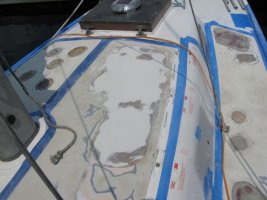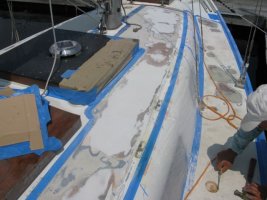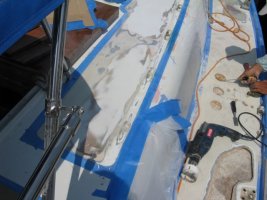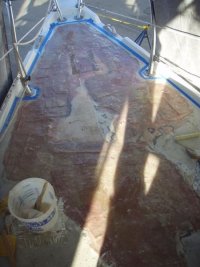Joe,
If you look up E-39B Pictures 1 thru 8 I think, you will see pictures of my re-coring project that I did. I did just what you are doing. You cant see it becasue it is not in the pictures but I feathered the fiberglass back around the areas where I cut out the balsa.
Then for my fiberglass job I used the really thick glass mat, it was roving roven and mat all in one, extremely thick stuff. I cut it into 8 inch squares. So I went accross all my areas that needed glassed in with 8" squares. Then for the second layer I over laped the joints of the first layer, then the third layer overlaped the second, and the fourth overlaped the third. It was over kill. I used some where around 700 of the 8 inch squares. But when it was all cured I was able to lightly grind it fairley smooth without losing a bunch of its thickness.
As for putting in the balsa I did the following. I would lay out about 50 1 cup containers on the table and fill them all with resin, then I would put in the thicking powder so it was pretty dam thick and would be able to fill the biggest gap that could happen as I glassed in my new foam balsa, (I used the foam balsa). It took one cup of resin for each piece of balsa I glued back in. I also put my balsa in with anywhere from 6 to 10 inch squares, I did not try to put any bigger pieces than that in at a time. I would not put the hardner in until I was ready to use the cup, it would take a couple of hours to to thru all the cups. I would fill in around ever square of the balsa and then put at least a 1/4" thick layer of my thick resin/harder over the piece, along with a 1/4" slap of resin/harder on the overhead. I held each piece in place until the resin kicked. Lots of resin would squirt out as I put the pieces in place, just had to keep one area clean for the next piece to go in place.
Gotta say you are doing the right thing with yours, I think it is worth every penny and I think I spent around $2,000 for all my fiberglass repairs, It is worth the hours you spend to get it done also. Gotta say I love, love, love those 36 grit sanding disk, they saved me alot of time.
Keep up the good work.
Mike
E-39B
S/V Sea Maid





